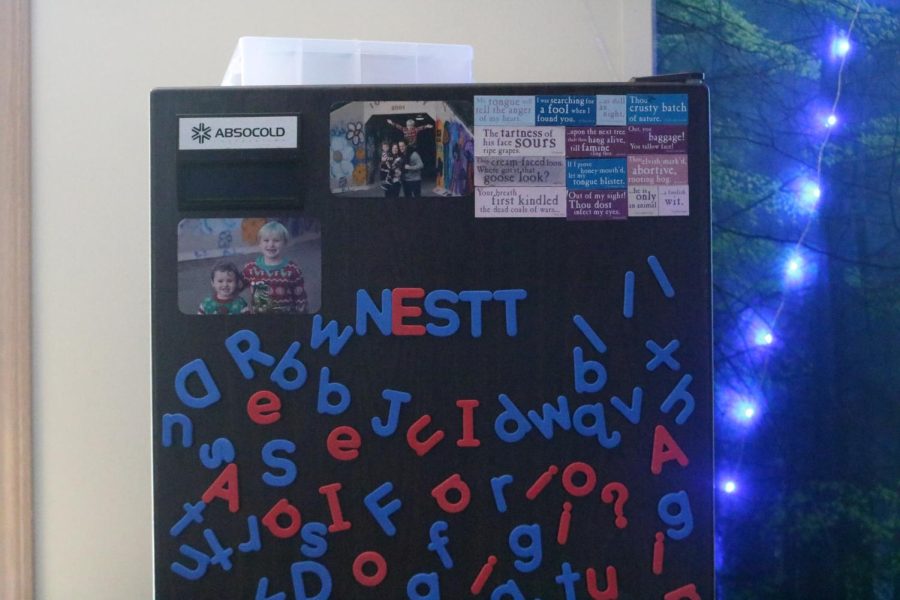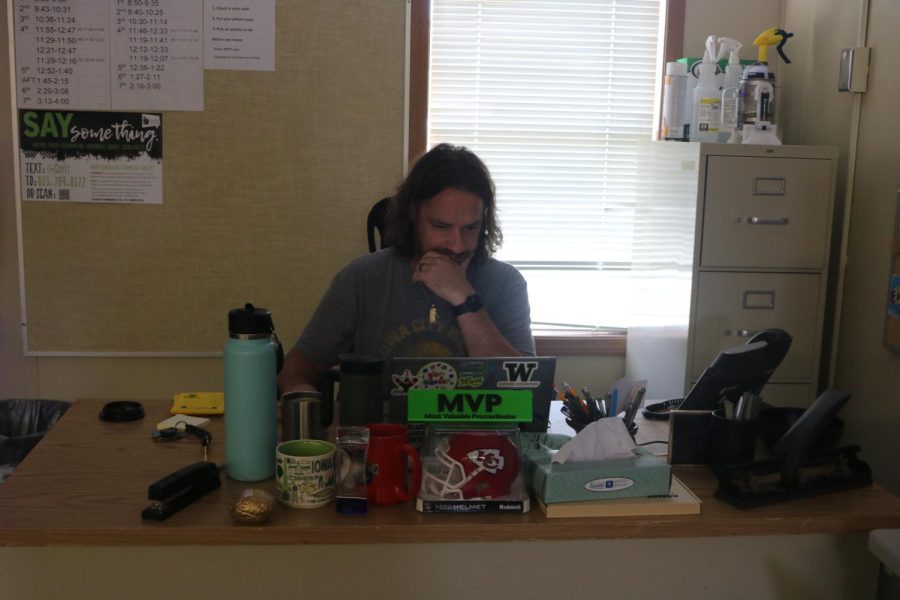NESTT at West
This school year, West High added the NESTT, a space where students can process emotions with mindfulness exercises and talk to a trained adult.
Adorned with letters and images, students can enjoy beverages and snacks from the mini fridge in the NESTT.
Riddled with anxiety, the first tear trails down your cheek. You keep your head low as your face reddens in discomfort. The need to escape the room engulfs your thoughts before your crying face is branded into your classmates’ memories. Faces start to turn; you need to get out of there, but you can’t. You have nowhere safe to go.
In response to the need for a centralized space for students to relieve emotions, teachers at City High School implemented Navigating Emotions and Stress Through Training, or the NESTT. Due to the positive reception from students and their parents, the administration sent emails to the state asking for a grant to fund the program. City High was awarded a grant from the state during the spring of 2020 to expand the NESTT. By the 2022-23 school year, a NESTT had been established in every high school and junior high school in the school district.
At West, the NESTT serves as a place for students to relax using an array of stress-relieving techniques such as participating in mindfulness activities or talking with Phil Keitel, the NESTT Coordinator. Keitel is a trained Engagement Intervention Strategist, or EIS, who has worked at West High for seven years as a paraeducator and Student Advisory Center, or SAC, coordinator. His primary role is to help students regulate their emotions.
“Within 10 minutes, I know the type of person they are. Are they quiet? Are they outgoing? Do they get mad easily? Do they not want to talk to adults? Do they just want to talk to adults because that’s all they need?” Keitel said. “All of that data processes when you walk in … If they don’t tell you, you kind of have to pry a little bit, but that’s part of the job.”
When walking into the NESTT, students are welcomed by aromatherapy diffusers, color-changing lights and bean bag chairs. Students can choose from a variety of relaxing items that include snacks and drinks, exercise balls, activity books, an ambient noise machine and over 50 different fidgets and stress balls.
Josie Friedman ’25, a student who has utilized the NESTT as a break from school, believes the environment Keitel has created provides students with a safe space to take time for themselves.
“I thought that it was a really comfortable place to be. They have a lot of different fidgets, or sensory toys, that you can use. It’s also just a very calm room to be in and Phil is really nice,” Friedman said.
Friedman appreciates the added privacy of the NESTT being in Temporary 10.
Students can report to the NESTT room in two ways: teacher recommendation or self-referral. The maximum amount of time that can be spent at the NESTT is 15 minutes per referral.
“The data shows that kids still need to be in class. When you miss more than 15 minutes of the class it can be hard to just go back in and figure out what you’re doing,” Keitel said.
NESTT, SPACE, or Student Prevention Access Connection Engagement, and the SFAs, or Student Family Advocates, work as a triage for student support. If Keitel is unable to provide students with the proper resources, he can send them elsewhere to get help. The NESTT is a good starting point for assessing students’ needs.
“You can come out here and then there’s someone to talk to you immediately and figure out, ‘Where do we best need to send you? Do you only need 10 or 15 minutes to get through some anxiety?’ Then this is the spot,” Keitel said.
If students are suicidal or require more than 15 minutes of attention, he redirects them to SPACE, a rebranding of the SAC, or the SFAs. He is not trained to help them but can see the signs and send them to the right places for help.
Kristin Brack is the EIS coordinator for SPACE. With connections across the community, she is able to help students with needs outside of school to make learning in the classroom easier. Brack helps solve issues at the root of their problems instead of letting them fester into fights or skipping class.
“We found that there was a really big stigma with the name ‘SAC,’ because it’s been ‘SAC’ for four or five years. They found that students thought it was a place where the ‘bad students’ go, and we did not want that stigma anymore,” Brack said. “We want everybody at West High to feel like they are engaged with their student body and teachers, and that they have access to resources at West High.”
Whether due to stress or simply saying hello to Keitel, students are always welcome at the NESTT.
Keitel mentions that adults can have a hard time understanding what students go through on a daily basis because they’ve already graduated from high school. However, the NESTT makes it easier for them to help teenagers process emotions and offer support.
“It’s easy to say, ‘Oh you’ll be okay. You’ll get over it.’ That may be true. It may not be true,” Keitel said. “The thing about the [mental health] stigma is that we want people to come and seek help.”
Friedman visits the NESTT when she’s feeling overwhelmed with schoolwork or to be in Keitel’s company.
“I love to talk to Phil all the time. While I’m there, I’m either doing schoolwork or drawing in my sketchbook that I have just because I get bored all the time in class, and it’s helpful to do something I like and then go back and be like, ‘Okay, well, now I can do this,’” Friedman said.
Even students who aren’t likely to ask for help now still have a space to vent and be themselves. The NESTT is a space for everybody.
“It gives all students power and freedom that they need help and gives them the space that they need to work through whatever they’re going through … It’s not just for the ‘bad kids’ or for the kids that have mental health issues,” Keitel said.
Your donation will support the student journalists of West High School. Your contribution will allow us to purchase Scholarship Yearbooks, newsroom equipment and cover our annual website hosting costs.

(She/her) Reem Kirja is the West Side Story print Profiles Editor and this is her second year on staff. She enjoys exploring different world issues and...

(she/her) Kamakshee Kuchhal is a senior at West High School and is super excited for her third (and last) year on West Side Story Print Staff. Besides...




